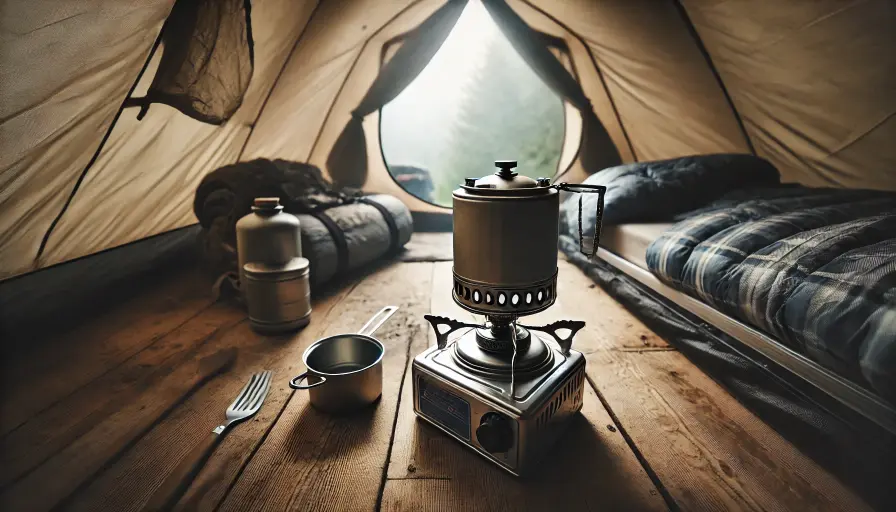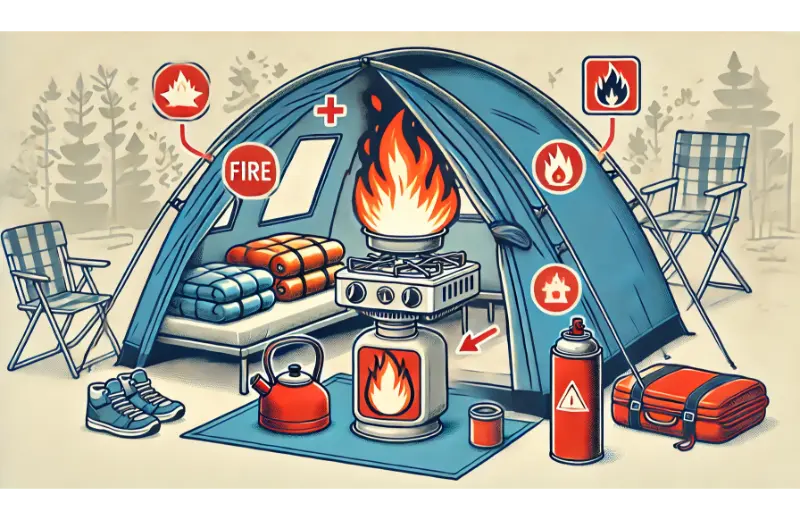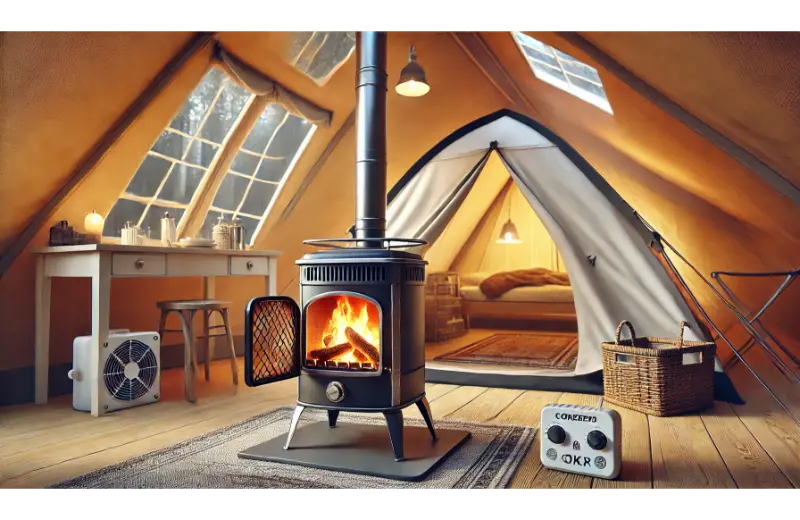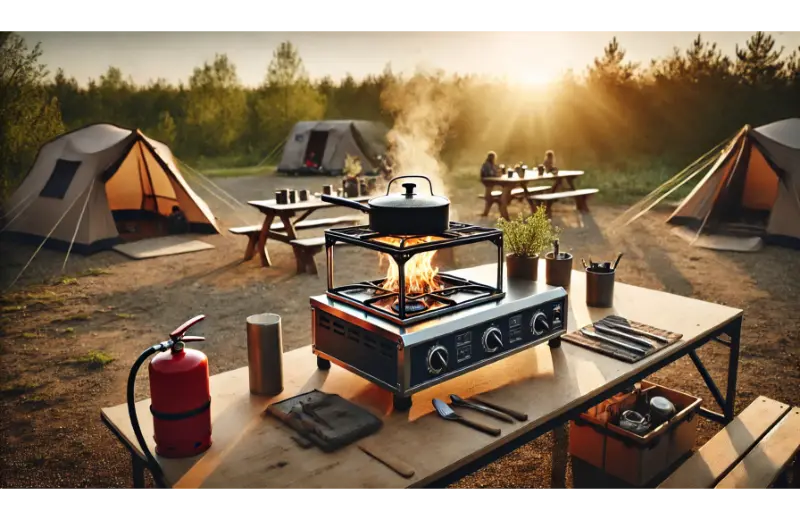Can You Use a Stove Inside a Tent? Safety Tips and Best Practices
Updated: 1 Jul 2024
308

Can You Use a Stove Inside a Tent?
Camping lets you escape daily life and connect with nature. It’s simple but comes with challenges. Staying warm and cooking meals are two big ones. Imagine being in your tent on a cold night. The wind is howling. You think about a hot meal and warm tent. But then you wonder: Can you safely use a stove inside a tent?
Many campers face this question. The idea of warmth and food sounds great. But using a stove indoors has risks. Fire hazards and carbon monoxide poisoning are real dangers.
In this article, we’ll look at how we can use different types of stoves inside a tent safely. We’ll share safety tips and best practices. We’ll talk about different stoves and share real-life stories. Experts will give their advice too. This will help you decide if using a stove in a tent is safe for you.
Risks of Using Stove Inside a Tent

1. Fire Hazards
Using a stove inside a tent can be dangerous. Tents are often made from flammable materials. A small spark can quickly turn into a big fire. Stoves can also tip over easily. This can start a fire or cause burns. Always keep flammable items away from the stove.
Click here to learn about what causes A gas stove to explode.
2. Carbon Monoxide Poisoning
Stoves produce carbon monoxide (CO). CO is a colorless, odorless gas. It can be deadly. When you use a stove in a closed space, CO can build up. This is very dangerous. Symptoms of CO poisoning include headache, dizziness, and nausea. Severe poisoning can cause death. Always ensure proper ventilation when using a stove.
3. Ventilation Issues
Proper airflow is crucial when using a stove in a tent. Without it, you risk CO buildup and suffocation. Open vents or windows to allow fresh air to enter. Never seal your tent completely while using a stove. Fresh air is your best defense against CO.
Understanding these risks is the first step. Now, let’s look at different types of stoves and how safe they are to use inside a tent.
Types of Stoves and Their Use in Tents
Can You Use a Canister Stove in a Tent
Using a canister stove inside a tent is dangerous due to the risk of carbon monoxide poisoning and fire hazards. Canister stoves emit carbon monoxide, which can be deadly in enclosed spaces like tents, and can also pose a fire risk.
To stay safe, it’s crucial to use canister stoves only in well-ventilated outdoor areas, avoid using them inside tents, and always have safety measures like fire extinguishers nearby. Safety should be a priority to ensure a risk-free camping experience.
Here are some pros and cons of using this type of stove in a tent:-
| Pros | Cons |
| Easy to use. | Limited fuel supply. |
| Lightweight and portable. | Can be unstable on uneven surfaces. |
| Quick to light and adjust. |
Safety Tips:
- Always place on a stable, flat surface.
- Keep away from tent walls and flammable materials.
- Ensure proper ventilation.
Can You Use a Liquid Fuel Stove in a Tent
Using a liquid fuel stove inside a tent is unsafe due to the risk of carbon monoxide poisoning and fire hazards. These stoves emit carbon monoxide, which can accumulate quickly in enclosed spaces like tents, leading to serious health risks.
Additionally, the potential for accidental fires is high, as liquid fuel stoves can ignite tent materials easily. To stay safe, it’s crucial to use liquid fuel stoves only outdoors in well-ventilated areas, away from tents and flammable materials, ensuring a safer camping experience for all.
Here are some pros and cons of using this type of stove in a tent:-
| Pros | Cons |
| Perform well in cold weather. | It can be more complicated to use. |
| Fuel is easy to find and refill. | Risk of fuel spills. |
Safety Tips:
- Fill and prime the stove outside the tent.
- Check for leaks before use.
- Keep a safe distance from the tent fabric.
Can you use a Wood-Burning Stove in a Tent
Using a wood-burning stove inside a tent is generally not recommended due to safety concerns. Wood-burning stoves produce carbon monoxide and pose a significant fire hazard in enclosed spaces like tents.
To ensure safety while camping, it’s best to use wood-burning stoves outdoors in well-ventilated areas away from tents and other flammable materials.
Here are some pros and cons of using this type of stove in a tent:-
| Pros | Cons |
| Fuel is readily available in nature. | Harder to control heat. |
| No need to carry fuel. | Produces a lot of smoke. |
Safety Tips:
- Only use in tents with a stove jack.
- Ensure the chimney is properly installed and vented.
- Keep flammable items away from the stove.
Can You Use an Electric Stove in a Tent
Using an electric stove inside a tent is generally not advisable due to safety risks. Electric stoves require a power source, often via a generator or power outlet, which can be impractical and unsafe in outdoor environments.
Moreover, the use of electrical appliances in a tent can pose fire hazards, especially if not properly managed. For safe camping, it’s recommended to use electric stoves in designated outdoor cooking areas with proper electrical connections and safety measures in place.
Here are some pros and cons of using this type of stove in a tent:-
| Pros | Cons |
| No risk of CO poisoning. | Requires a power source. |
| Easy to control and safe. | Can be heavy and less portable. |
Safety Tips:
- Use in a well-ventilated area.
- Ensure the electric supply is safe and dry.
- Avoid using near water or damp areas.
Each stove type has its pros and cons. Understanding these can help you choose the best one for your needs. Next, we’ll discuss safety precautions and best practices for using a stove inside a tent.
Safety Precautions and Best Practices

Proper Ventilation Techniques
- Open Vents and Windows: Always keep tent vents and windows open while using a stove. This allows fresh air to circulate and reduces the risk of carbon monoxide buildup.
- Use a Carbon Monoxide Detector: Place a portable carbon monoxide detector inside your tent. It can alert you to dangerous levels of CO.
- Set Up Near Tent Entrance: Position the stove near the tent entrance for better airflow.
Fire Safety Measures
- Keep Flammable Materials Away: Ensure that sleeping bags, clothing, and other flammable items are kept away from the stove.
- Use a Fire Extinguisher or Fire Blanket: Have a small fire extinguisher or fire blanket on hand. Know how to use it in case of an emergency.
- Create a Safe Cooking Area: Use a heat-resistant mat or surface under the stove. This can prevent accidental fires from spills or sparks.
Choosing the Right Location
- Flat, Stable Surface: Always place the stove on a flat, stable surface. This helps prevent tipping and accidents.
- Safe Distance from Sleeping Area: Keep the stove away from where you sleep. This reduces the risk of fire hazards and CO exposure.
- Clear Cooking Space: Maintain a clear area around the stove. Ensure there is enough space to move safely without knocking it over.
Regular Equipment Checks
- Inspect Stove Before Use: Check the stove for any damage or leaks before each use. Replace any faulty parts immediately.
- Maintain Cleanliness: Keep the stove clean and free from debris. This helps ensure it functions properly and reduces fire risks.
- Monitor Fuel Levels: Keep an eye on fuel levels to avoid running out unexpectedly. Refill outside the tent when necessary.
Following these safety precautions can significantly reduce risks. Next, we’ll explore alternative solutions for cooking and staying warm while camping.
Alternative Solutions
Cooking Outside the Tent

- Benefits of Outdoor Cooking:
- No risk of carbon monoxide buildup.
- Reduces fire hazards.
- Keeps the tent clean and odor-free.
- Setting Up a Safe Outdoor Cooking Area:
- Choose a Flat, Open Space: Find a stable, flat area away from dry grass and flammable materials.
- Use a Windshield: Protect the stove from wind to maintain a steady flame.
- Keep a Water Source Nearby: Have water or a fire extinguisher close in case of emergency.
Vestibule Cooking
- Advantages of Vestibule Cooking:
- Provides shelter from wind and rain.
- Keeps cooking gear outside the main tent area.
- How to Safely Cook in the Vestibule:
- Proper Ventilation: Ensure the vestibule is well-ventilated to prevent carbon monoxide buildup.
- Fire-Resistant Mat: Place a fire-resistant mat under the stove to protect the tent floor.
- Safe Setup: Keep flammable items away and use a stable surface.
Using a Stove Jack
What is a Stove Jack?:
A stove jack is a heat-resistant port installed in the tent wall or roof, allowing for the safe use of a wood-burning stove.
How to Install and Use a Stove Jack Safely:
- Proper Installation: Follow the manufacturer’s instructions for installing the stove jack securely.
- Ventilation: Ensure the chimney extends outside the tent for proper venting of smoke and gases.
- Heat Shield: Use a heat shield around the stove to protect the tent fabric from heat.
Exploring these alternative solutions can help you find safer ways to cook and stay warm while camping. Next, we’ll look at real-life experiences and expert opinions on using stoves inside tents.
Real-Life Experiences and Expert Opinions
Camper Testimonials
John’s Experience:
“I used a small canister stove in my tent during a winter camping trip. I made sure to keep the vents open and had a carbon monoxide detector with me. It was convenient and kept me warm, but I was always cautious about fire safety.”
Emily’s Story:
“I once tried using a wood-burning stove in my tent. It was a special tent with a stove jack, so I felt safe. The key was ensuring the chimney was properly vented. It worked great, but I wouldn’t recommend it without the right equipment.”
Michael’s Adventure:
“Cooking in the vestibule was a game-changer for me. It kept the tent warm without the risks of indoor cooking. Just make sure you have enough ventilation and keep the cooking area clear of flammable items.”
Expert Advice
Outdoor Survival Expert, Sarah Thompson:
“Using a stove inside a tent can be risky. Always prioritize ventilation and have a carbon monoxide detector. If possible, cook outside or in the vestibule to minimize risks.”
Camping Gear Manufacturer, Alex Reynolds:
“Many modern tents are not designed for indoor stove use. Look for tents with stove jacks if you plan to use a wood-burning stove. Always follow the manufacturer’s safety guidelines.”
Fire Safety Specialist, Dr. Lisa Carter:
“Fire safety is crucial when using any stove indoors. Keep a fire extinguisher handy, and never leave the stove unattended. Educate yourself on the symptoms of carbon monoxide poisoning and take preventive measures.”
Real-life experiences and expert opinions provide valuable insights. They highlight the importance of safety and proper equipment.
Can You Use Stove Inside A Tent: Final Thought
Using a stove inside a tent requires careful consideration and strict adherence to safety measures. While it can provide warmth and convenience, the potential risks should not be underestimated. Prioritize your safety and that of your fellow campers. Always follow the manufacturer’s guidelines and expert advice.
Camping should be a fun and safe experience. You can enjoy the great outdoors while staying warm and well-fed by making informed decisions about stove use. Remember, safety comes first.
FAQs
Is it okay to cook inside a tent?
Cooking inside a tent is risky due to fire hazards and carbon monoxide poisoning. Ensure proper ventilation and use a carbon monoxide detector if you must cook inside. Always follow safety precautions.
How do you cook in a tent when it rains?
Cook in the tent’s vestibule to ensure better ventilation. Use a fire-resistant mat and keep flammable items away. Alternatively, set up a tarp or portable canopy outside for a sheltered cooking area.
Can you cook in a camping shelter?
Yes, cooking in a camping shelter is possible with proper ventilation. Ensure good airflow, use a fire-resistant surface, and keep flammable materials away from the stove.
Can any stove be used inside a tent?
No, not all stoves are safe for indoor use. Check the manufacturer’s recommendations.
What is the safest type of stove to use in a tent?
Electric stoves are generally safest due to the lack of CO emissions, but they require a power source.
How can I ensure proper ventilation in my tent?
Keep vents and windows open and use a carbon monoxide detector.
What should I do if I experience symptoms of carbon monoxide poisoning?
Immediately move to fresh air and seek medical help.
Are there specific tents designed for indoor stove use?
Yes, look for tents with stove jacks and proper ventilation systems.
Additional Resources
Share your experiences and tips in the comments below.
Please Write Your Comments